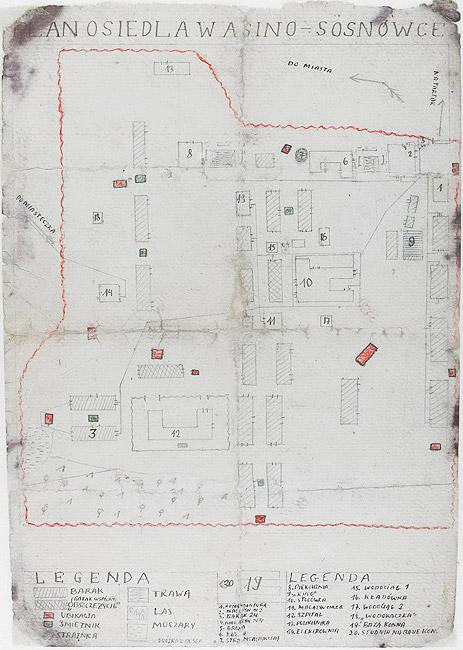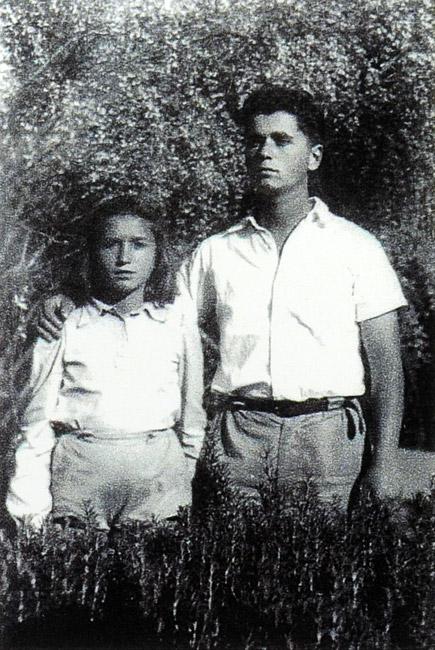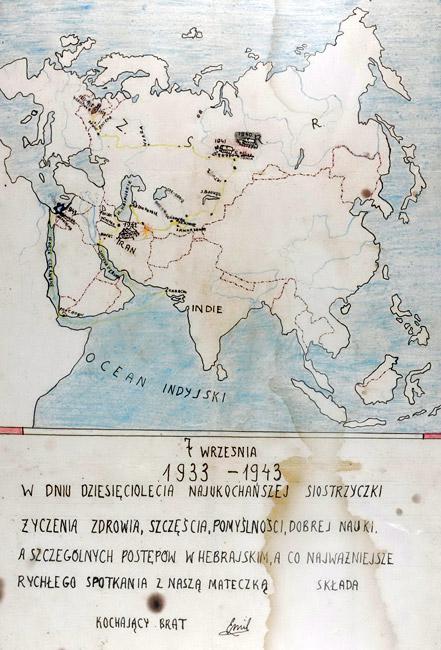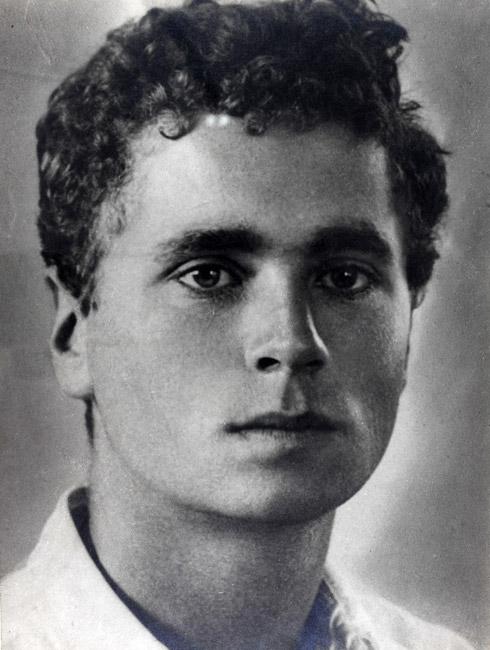Before the war, the Landau family was a member of the upper class of Warsaw Jewish society. Her mother was a pianist and her extended family included many musicians and doctors. Thanks to her father's job as a lawyer and accounts manager for Gestetner in Warsaw the family enjoyed economic prosperity. Elina remembers outings around Warsaw with the nanny who lived with them and looked after her and her brother. The children grew up immersed in Polish culture and Emil dreamed of studying Polish literature in university. Christmas is the holiday that Elina remembers from home. They were a liberal, secular family and Elina only became aware of her Jewish identity during the war.
The family owned a car, one of the signs of their affluence. Following the outbreak of the war they fled in their own car, but at some point they ran out of petrol and continued their way on foot. This completed the sudden upheaval in the family's fortunes as, like everyone else, the well-connected family became refugees.
They reached Rivne, a city in northwest Ukraine on the border between Poland and the Soviet Union. Rivne was under Soviet rule and the many refugees who wanted to gain entry were presented with the pre-condition of accepting Soviet citizenship. The Landaus, a patriotic Polish family, refused to accept Soviet citizenship. Accordingly, Mietek was conscripted to the Red Army; Fania and her two children, together with hundreds of other refugees that had retained their Polish citizenship, boarded trains and were deported to the East. At the end of a three week journey under inhuman conditions, the refugees were taken to the Asino labor camp in the Tomsk region of Siberia. A plan that Emil sketched during their time there provides detailed information about the camp structure and living conditions. Elina's memories of Asino are of terrible cold and constant hunger. Another aspect that she remembers is the fear; the camp was surrounded by dense forests and the rumors of bears and wolves roaming in the forest accompanied Elina and her friends when they would go out to collect berries in an attempt to quiet the gnawing hunger.
In accordance with the agreement for the renewal of diplomatic relations between Poland and the Soviet Union signed on 30 July 1941, all Polish citizens imprisoned in camps in the Soviet Union were granted amnesty. Most of the refugees who were freed continued their journeys eastwards to Uzbekistan. Thus Fania, Emil and Elina reached Samarqand. Elina recalls pictures of Stalin everywhere and standing in line for hours for bread. One day, their father Mietek returned; he had been sent home by the army after being diagnosed with typhus. The reunion was brief; he died after just a few days at home. Fania, who sensed that she had lost any chance of caring for her children and saving them from starvation, decided in desperation, like other parents, to place them in a Christian children's home. From that moment, Emil acted as both father and mother for his younger sister. His presence gave her a sense of security in the unfamiliar institution. At the same time as they were learning the Christian prayers, Elina's brother informed her, for the first time, of her Jewish identity.
Some months later an emissary from the Youth Aliyah visited the children's home in order to remove the Jewish children. This was in accordance with the 1942 agreement between the Polish government-in-exile and the Soviet Union which permitted the transfer of 24,000 Polish soldiers and refugees in Soviet territory to Tehran, then under British rule. When they arrived in Tehran Elina was already nine years old. The children, who had mostly arrived without their parents, lived in an orphanage that had been established for them. The emissaries that had been send to them told the children about Eretz Israel, a place where they would find rest from all their wanderings. Elina found it hard to believe in the existence of such a place and to her, the stories about Eretz Israel sounded like fairy tales.
In January 1943, following seven months in Tehran and receiving immigration visas to Eretz Israel from the British mandate authorities, the children set sail to Karachi in India (today Pakistan) and from there to Suez. On 18 February 1943 they arrived in Eretz Israel by train. Together with another ten "Tehran Children", Emil and Elina (who in Israel became Emmanuel and Ilana) were sent to Kibbutz Ginegar in the Jezreel Valley.
For her tenth birthday, Emil gave his sister a map that he had sketched, delineating the route that they had travelled from Poland to Eretz Israel. At the bottom of the map Emil added the dedication:
7 September
1933-1943
For my beloved sister's tenth birthday,
Blessings of health, happiness and success. May you succeed in your studies and especially in Hebrew.
And most important of all – may we be reunited with Mummy soon.
Your loving brother, Emil.
7/9/1943, Ginegar
Unfortunately, later on, they were informed that by Elina's tenth birthday their mother had already passed away. She had died of starvation and exhaustion in Samarqand on 14 August 1943.
Emil, who had dreamed in his childhood of studying at a Polish university, decided that in Eretz Israel, being a farmer was of greater importance. He was accepted to the Kaduri agricultural school. When he had successfully completed his studies at Kaduri he enlisted in the Palmach and trained at Ramat Yohanan. At this time he fulfilled his responsibilities to his sister through writing letters in which he advised her and guided her through decisions.
On 17 March 1948, Emil took part in the ambush at Kiryat Motzkin of an Arab weapons convoy on its way to Haifa. While they were gaining control over the convoy, he jumped onto one of the trucks that was loaded with weapons and tried to start the engine and to transfer it to the Jewish forces. Shots that were fired at the truck caused it to explode, killing Emil-Emmanuel.
In a ceremony conducted on 17 July 1949 Emmanuel Landau was awarded the "Hero of Israel" award for excellence and bravery in action together with eleven other recipients who had fought in the War of Independence. Ilana, who had been bereaved for the third time, accepted the honor on his behalf.
Ilana married the artist Hanania Karniel and the couple had three children. Out of a desire to use her childhood experiences for the good of the next generation, Ilana became a social worker, dedicating her life to the needs of children in difficult circumstances.
As part of the Gathering the Fragments campaign, Ilana gave Yad Vashem the diagram of the Asino labor camp that her brother had sketched, together with the map that he had given her as a birthday present following their arrival in Eretz Israel.














